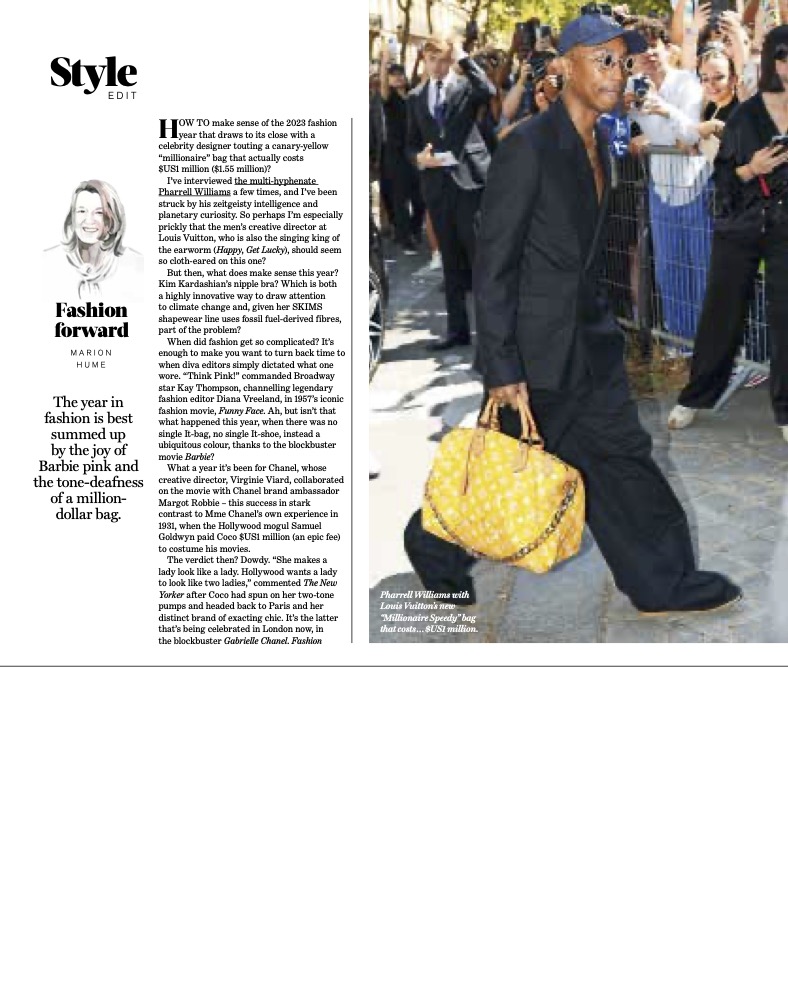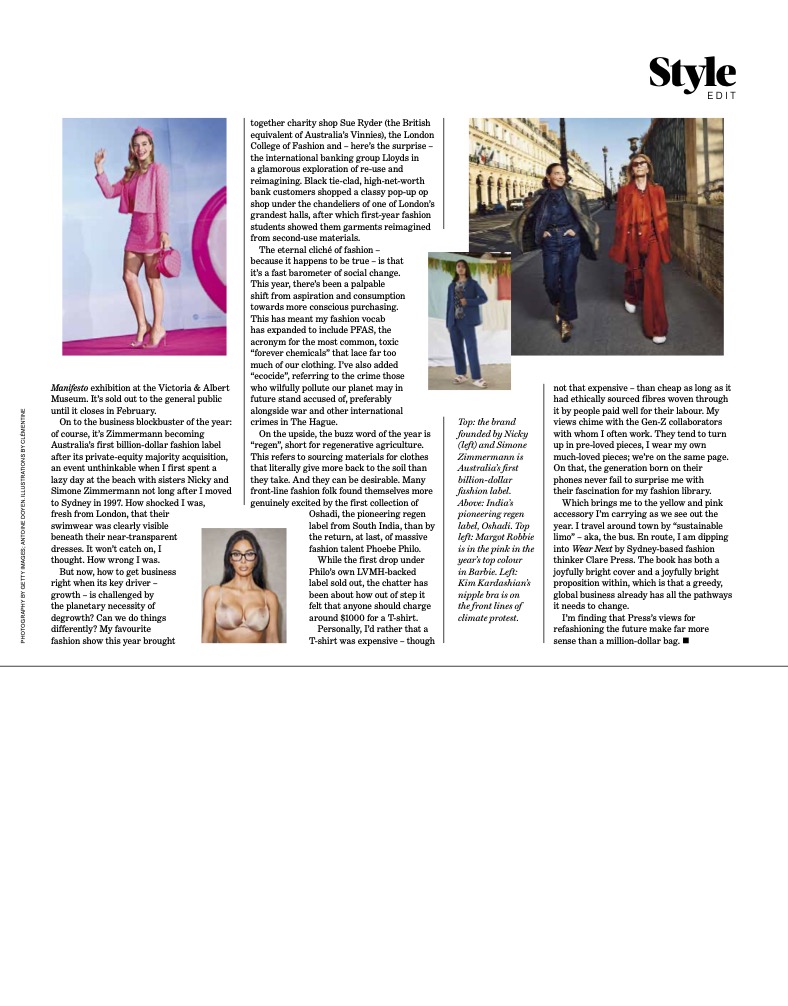



by Marion Hume
A thrill goes through your body like a shiver when you stumble on an absolute master of the art of fashion writing.
What? You think it is not an art? Just a lot of waffle about frocks? Try this; “Anne was wearing, that day, rose pink and dove grey. The colours should have had a fresh maidenly charm; but all he could think of were stretched innards, umbles and tripes, grey-pink intestines looped out of a living body…The pearls around her long neck looked to him like little beads of fat, and as she argued she would reach up and tug them; he kept his eyes on her fingertips, nails flashing like tiny knives.”
Even if you don’t yet know who this Anne is, you do know she is a dangerous woman. When you find out the lady described is Anne Boleyn and that she has schemed to win a king and dipped her hands in blood to be crowned queen, the writing is more powerful still. For you see ahead the puddle of gore in which her little head will lie once severed by an executioner’s sword.
The words are penned by the peerless Hilary Mantel, before whom even the judges of the world’s most prestigious literary prize, the Man Booker, bow down. Mantel is the author of “Wolf Hall” and its 2012 follow-up, “Bring Up the Bodies”, both of which chart the rise of Henry VIII’s right hand man, Thomas Cromwell. Even if you have zero taste for the Tudors, might I urge you to reach for Mantel’s double bill set in 16th century England, despite this requiring a considerable commitment to 2 x 400 pages? For within lie not only some of the greatest descriptions of clothing put to the page but also perhaps the most sage and searing portrait of businessman-as-survivor that you will ever find.
You don’t know anything about Thomas Cromwell? Neither did I; indeed I had him confused with Oliver Cromwell, the “Roundhead” who came along more half a century later, wore monochrome black and white and decreed that the cavaliers must stop wearing such jaunty outfits. (Were fashion of little importance, why, throughout history, have powerful men been so determined to ban it?)
Thomas Cromwell, in contrast, sported a nana-style black coat with a fur collar, accessorized by a horrible hat, (at least when he sat for the court painter, Holbein). He was Henry VIII’s wingman, from the days when the young king looked a bit like Jonathan Rhys Meyers in the US TV series “the Tudors” right through to when the monarch was as massive as Gerald Depardieu.
Cromwell was executed in 1540 then had a long wait for a truly great biographer. For until Mantel turned her eagle eye and diamond lines upon him, who knew it was this Machiavelian minister who first noticed the it-bag? “This season young men carry their effects in soft pale leather bags, in imitation of the agents for the Fugger bank, who travel all over Europe and set the fashion. The bags are heart-shaped….” Thomas Cromwell observes in “Bring up the Bodies”.
My reading matter is more often Grazia than great literature. (And what’s not to love about a glossy where the wordsmiths come up with new vocabulary weekly? Currently, I’m liking the economy of “FROWers” meaning the front row set). But when time, or being in bed with flu allow, what better than to behold a young queen, busy spending recklessly on the luxury goods of the 1530s – damask clothes, Spanish leather, gold-fringed gloves – while a minister in a bad hat and plain Jane Seymour, dressed in black and dispatching messengers to the king to return his gift of jewels undo and outsmart her? The power of clothes indeed.
by Marion Hume
Is there a seasoned celebrity who still enjoys the red carpet? Or does it become akin to running the gauntlet in high heels: a trial to be endured while starved of oxygen in a gussied-up gown?
For if it really were fun – beyond that thrilling first time – why, in every interview, do celebrity couples (The Beckhams, the Jolie-Pitts) insist they prefer staying home? You can see where they are coming from. Even in a not famous life, the lure of a glass of wine and a box set is strong.
But whatever business you are in, you can’t just stay on the sofa; not when showing up counts towards success and you’ve got to be seen building your “brand”. For we’re all brands these days, on message, out there, smiling. What can make it even harder is the party presence of those glistening, glamourous people, the kind who don’t appear to be bogged with the hard work of a day job. Add to that too much champagne and the fact that, of course, you’ve got to tweet and blog and facebook and it all adds up to exhausting.
And so, a solution to this modern dilemma; a job share, if you will. What if, indeed you did stay home (pass the remote) thus clearing space by the velvet rope for the paps to snap the beautiful people head-to-toe? What if you got on with the work side, working late if need be, and you simply hired a “ghost celebrity” (duties to include anodyne tweeting) to dress up, go out and be a better you?
A better you? Of course. Ghost writers are always way smarter than those they’re doubling for. Sending out someone with a body of death or at least all their own hair is merely the flip of a supermodel or a sportsman hiring a brainy, flabby, shabby-looking scribe.
The requirement for a ghost celebrity would not be restricted to those with red carpet lives. You might even explore a ghost celebrity time share, so you could hire someone smoking hot on a job-by-job basis, perhaps to show up at your school reunion or to attend that tax planning conference in Adelaide. Given everyone is already ameliorating the images they post on social networking sites, or at the very least keeping up the photos that are, in truth, ages old, this shouldn’t be that shocking. And you’ve got to admit the absolute brilliance of someone else watching their weight for you.
How would you select your ghost celebrity? It would be a two-way process, with either side entitled to walk away before the contract was signed. When I was approached to be a ghost writer, I was excited until I met the celebrity and it dawned on me than there could be no worse purgatory than a year spent sieving through what was – or in this case, was not, in her head and that no amount of cash would compensate. As with a ghost writer, the contract would be detailed and legalled. (Personally, I might insist no leopard print be worn in my name and that an over-reliance on ozone-destroying hairspray be deemed unacceptable).
What you could not then do is show up yourself, any more than a ghost writer can pop out from behind the floral arrangement at the press launch of a glittering tell all autobiography and shout “I’m…. fill famous name in here”. Ah I can see I might need to workshop this more. For why, by delegating to someone else, would I risk missing out? How could I be sure that an event I was ducking out of might not morph into the time of my life? Guess it’s time to polish the party shoes and not let some other Cinderella go to the ball, after all.
by Marion Hume
Fashion exhibitions are, if not ten-a-penny, given they are costly to stage, certainly pretty ubiquitous.
But can you remember when fashion wasn’t thought to be “serious” enough to deserve gallery space or attention in a museum calendar? An upside of that was one might stumble on an unexpected gem, as a friend and I did when we noticed the gates of a usually private Parisian mansion were open in order to share a bijou collection of artifacts celebrating the client-couturier relationship between the late, lady of the house and that greatest couturier of the 20th century, Cristobal Balenciaga.
The last time I saw a Balenciaga exhibition, it was at Le Louvre. It featured as many clothes by today’s designer for the brand, Nicolas Ghesquiere as by the long dead namesake. Fashion exhibitions have become like movie blockbusters, enjoyable in that they are mega, but with the commercial preoccupation of reinforcing brand message definitely front of mind.
What a joy then, to be in Singapore in time to catch “In the Mood for the Cheongsam” at The National Museum – the title echoing, of course, the movie that introduced Asian cinema, Maggie Cheung and the serene sexiness of a covered-up style that follows every curve to a wider world.
While the exhibition has now closed, I have a hunch its influence will spread. Fashion creatives throw their nets very wide and surely, by now, someone has shared the images from the excellent catalogue on Pinterest. (Who bothers with Facebook anymore?) For alongside the expected (black satin, gold dragons) were groovy geometric and intriguing hot floral prints that looked so contemporary. The cheongsam provides a broad canvas for decorative experiment, although not too broad, given its second-skin proportions, these part of the reason it dipped out of fashion once Western styles became widely available across Asia.
It disappeared from sight in mainland China, where it began, for other, political reasons. On a trip back to Beijing recently, I met students from the nation’s leading fashion university. To those who have grown up with Western labels and with mothers, perhaps grandmothers, who wore Mao suits, the cheongsam is as exotic as it is to me, except perhaps through the threads that tangle back to a long-ago history. So at the exhibition in Singapore, I started thinking; given we are anticipating a new generation of designers to emerge from China, what might they do to reclaim, reinvent, reinvigorate this glamourous garment?
That’s been done already of course. Shanghai Tang, the witty Hong Kong label that takes a culture’s cliches, then, gloriously, spins these right back at you always has a cheongsam in its collections. Vivienne Tam in New York, Shiatzy Chen from Taiwan, often play with the sartorial markers of their heritage. The exhibition introduced me to the fresh talent of Priscilla Shunmugan, whose heritage is part-Chinese, part Indian and that got me thinking about how in India, the seductive beauty of the sari absolutely competes alongside Valentino, Versace, Cavalli while Hermes sells Lyon-silk printed saris there. Might the cheongsam, in some uncliched way, stage a bigger comeback?
The exhibition included a gown from John Galliano’s 1997 Dior show, inspired by the handover of Hong Kong, which I saw and adored. Yet while Galliano created so many ravishingly riffs right across a mash-up of cultures during his time at Dior, in retrospect, the cheongsam tripped him up, veering perilously close to drag. A cheongsam-inspired cocktail dress by the late Alexander McQueen looked leaden. “It needs an Asian Miuccia Prada,” I thought; a designer who takes historical references forward to create something new. I stopped in my tracks at a studio portrait of a woman in a loose, wildly patterned cotton cheongsam, accessorized with beguilingly elongated Mary Jane shoes. So modern. The date, “late 1920s”.
I bet that’s already been shared via Pinterest and has someone’s creative juices flowing.